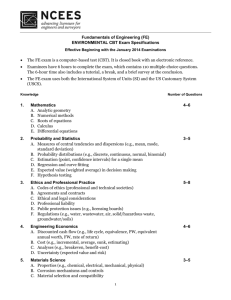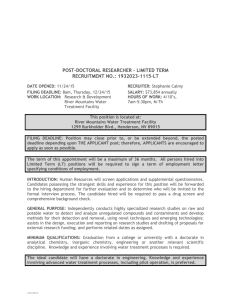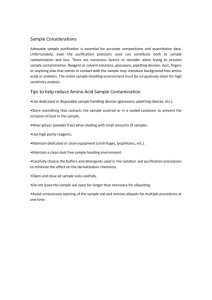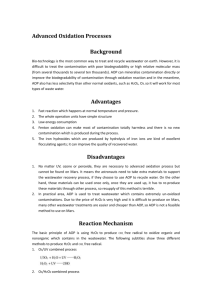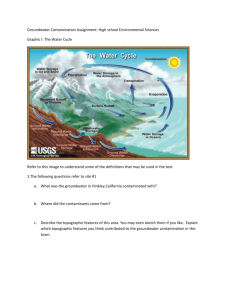Baird-11-The-Pollution-and-Purification-of-Water
advertisement
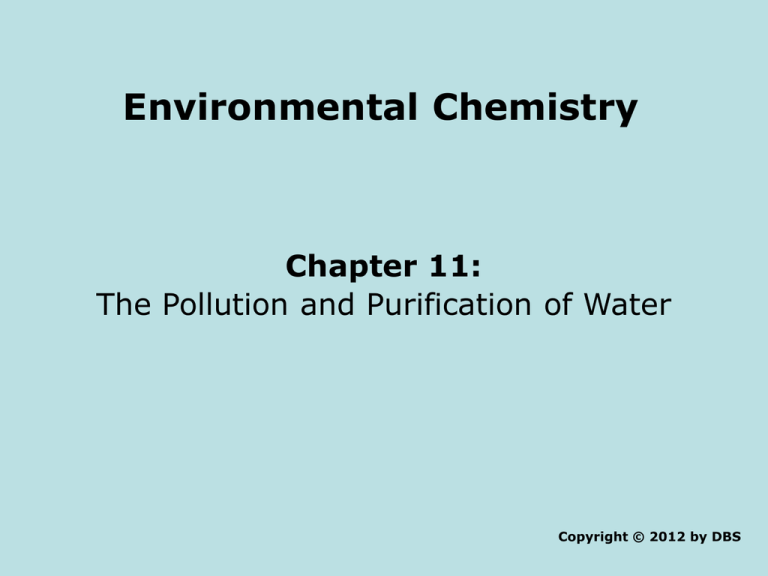
Environmental Chemistry Chapter 11: The Pollution and Purification of Water Copyright © 2012 by DBS Contents • • • • Treatment Processes Disinfection of Water Clean Water Act Chemical Contamination Water Disinfection • • • The quality of surface and ground water varies widely Need to be treated before it can be used for human consumption The purification of water involves: Non-disinfection 1. Aeration of water 2. Removal of Ca2+ and Mg2+ 3. Removal of colloidal particles by precipitation 4. Settling & Filtering of water Disinfection 1. Disinfection by membranes 2. Ultraviolet Radiation 3. Ozone and chlorine dioxide Water Disinfection Aeration 1. Aeration of water Removal of dissolved gases (e.g. H2S) and organosulfur compounds Removal of volatile organic compounds Oxidation of Fe2+ to Fe3+ and precipitation as insoluble Fe(OH)3 Water Disinfection Removal of Ca2+ and Mg2+ 2. Removal of colloidal particles by Precipitation Particle of diameter less than 1μm diameter – referred as colloidal particles - suspend in water Weakly bound molecules and ions Charge neutralization by the addition of Fe2(SO4)3 and Al2(SO4)3 (alum) causes coagulation and form removable precipitate Water Disinfection Removal of Ca2+ and Mg2+ 3. These ions can be removed by precipitation following addition of phosphate and filtration Ca2+ ions are also more commonly removed by the addition of soluble carbonate (Na2CO3) Ca2+ + CO32- → CaCO3(s) Mg2+ is precipitated as Mg(OH)2 under alkaline conditions Disinfection of Water • • Removal of biological contaminants is equally important Microorganisms in raw water include – Bacteria – Salmonella genus ..E coli O157:H7 responsible for typhoid – Viruses – polio, Hepatitus-A – Protozoans (single celled species) – Cryptosporidium, Giardia Disinfection of Water Filtering • • • Micro-organisms commonly attach to particles Large particles may be easily removed by filtration Filtering through sand is the oldest known form of water purification http://www.ars.usda.gov/is/video/vnr/grassbuffers.htm Disinfection of Water Membrane Technology • • • Must be pre-treated to remove larger particles Membranes of pores 0.002 -10 mm diameter facilitates microfiltration and ultrafiltration When pumped under pressure nanofilters allow removal of Ca2+ and Mg2+ ions Disinfection of Water Membrane Technology Reverse Osmosis Semipermeable membrane composed of cellulose acetate or triacetate allows only water molecules to pass through Effective in removal of particles, organic molecules and biological species. Process is widely used in desalination of water Small units are available for household use Disinfection of Water UV-irradiation • • • • 10s exposure of UV-C light (254 nm) is sufficient to eliminate the toxic microorganisms (including cryptosporidium) Absorption of UV-C results in the formation of new covalent bonds between nearby thiamine units on the same DNA strand Germicidal action of UV-light thus disrupts the DNA activity and prevents subsequent replication Dissolved iron and other UV-absorbing compounds make this treatment less effective http://www.purewaterhouse.com/alfaresidential.htm Disinfection of Water Chemical Methods • Ozone Treatment (Los Angeles and Montreal) – Ozone cannot be stored or shipped – It is produced by electrical discharge (2000 V) – Ozone is short-lived, hence no long-term residual effects – If Br- is present it generates bromate ion Br- + 3O3 → BrO3- + 3O2 • Bromate ions react with organic moleules (if present) and produce toxic organobromine compounds • Chlorine Dioxide, ClO2 Treatment (more than 300 North American cities) – Readily oxidize molecules by extracting electrons ClO2 + 4H+ + 5e- →Cl- + 2H2O – – – Much smaller amounts of toxic organic by-products Usually stored in the reduced form as chlorite (Sodium chlorite) ClO2- → ClO2 + eLeaves residual chlorite and chlorate ions have raised some concerns Disinfection of Water Chlorination: Production of Hypochlorous Acid • • • Most common purification agent used in North America Like ozone, HOCl cannot be stored Generated by dissolving Cl2 Cl2(g) + H2O(aq) ⇌ HOCl(aq) + H+ + Cl- • In swimming pools hypochlorite salt, NaOCl or Ca(OCl)2 is used OCl- + H2O ⇌ HOCl + OH- • Close control of the pH is crucial to avoid corrosion (acidic) or formation of chloroamines, NH2Cl, NHCl2 and NCl3 (alkaline) NH3 + 3HOCl → NCl3 + 3H2O • pH in swimming pools (slightly above pH 7) is controlled by NaHSO4 and Na2CO3 Disinfection of Water Chlorination: Production of Hypochlorous Acid Advantages: • Proved important in protecting human health (eradicated typhoid & cholera) • Since some chlorine remains in water, it prevents subsequent bacterial contamination • Chloramines or combined chlorine provide longer residual protection • EPA has set MRDLs of 4 ppm for both chlorine and chloramine in drinking water Disadvantages: • Pathazonic bacteria called Cryptospordium is resistant to common chemical treatment procedures. • HOCl is not only an oxidizing agent but also a chlorinating agent – Formation haloacetic acids (EPA restriction of <60 ppb) – phenols are converted into more toxic chlrinated phenols – Reaction of HOCl with organic matter (humic acid) produces trihalomethanes CHX3 (EPA limit 80 ppb) THM Disinfection of Water Chlorination By-Products • • • • • Humic acids react with HOCl to form chlorinated phenols Ring cleaves at C-2 and C-3 Terminal C is chlorinated -CCl3 group is displaced by OHTrihalomethanes are suspected carcinogens chloroform Clean Water Act • • • • • • Growing public awareness and concern for controlling water pollution led to enactment of the Federal Water Pollution Control Act Amendments of 1972. As amended in 1977, this law became commonly known as the Clean Water Act. The Act established the basic structure for regulating discharges of pollutants into the waters of the United States. It gave EPA the authority to implement pollution control programs such as setting wastewater standards for industry. The Clean Water Act also continued requirements to set water quality standards for all contaminants in surface waters. The Act made it unlawful for any person to discharge any pollutant from a point source into navigable waters, unless a permit was obtained under its provisions. It also funded the construction of sewage treatment plants under the construction grants program and recognized the need for planning http://www.epa.gov/r5water/cwa.htm Point-Of-Use Water-Disinfection • P474-477 Ground Water Supply, Contamination, Remediation Ground water refers to water in the saturated zone -0.6% of the world’stotal water supply Water table near the surface - swamps Water table above the surface - lakes Majority of ground water use in the US is for irrigation water resources are depleting rapidly in some places In the US about 39% of the of the water used for public supplies are extracted from wells Global Pools and Fluxes of Water on Earth Ground Water Contamination of Ground Water • Although concerned about pollution of surface water in rivers and lakes for a long time, the contamination of ground water was not recognized until 1980s! Nitrates and nitrosamines Nitrates in water originates mainly from 4 sources Application of nitrogen fertilizers and animal manure Atmospheric deposition Human sewage deposited in setic systems Cultivation of the soil Ground Water Nitrates in Water and Health Hazards • • • • The natural concentration in the US is ~2 ppm. (US-EPA standard for MCL is 10 ppm) The main source of nitrate is runoff from agricultural lands Rural areas with high nitrogen input, well drained soil and little woodland are at greater risk Methemoglobinemia in infants –blue-baby syndrome Nitrate is reduced nitrite (NO2-) by bacteria in the stomach Nitrite then combines and oxidizes the hemoglobin in blood thereby preventing oxygen supply • Potential risk of stomach and bladder cancer in adults Nitrosamines • • • Excess nitrate ions in drinking water can cause increase incidence of stomach cancer Conversion of nitrate to nitrite in the stomach Reaction between nitrite and amines can result in the formation of nitrosamines – a known carcinogen N-nitrosodimethylamine NDMA can transfer methyl group to N- or O- group of DNA base and alter the instructional code for protein synthesis in the cell – In 1980s the commercial beer had 3000 ppt, reduced now to 70 ppt Ground Water Contamination by Organic Chemicals • Municipal landfills and industrial waste disposal sites are often the sources of contaminants Typical organic contaminants include: – Chlorinated solvents such as trichloroethylene – Hydrocarbons from gasoline and other petroleum products (benzene, toluene, xylene) – MTBE Nonpoint Source (NPS) Pollution Unlike pollution from industrial and sewage treatment plants, comes from many diffuse sources. NPS pollution is caused by rainfall or snowmelt moving over and through the ground. As the runoff moves, it picks up and carries away natural and humanmade pollutants, finally depositing them into lakes, rivers, wetlands, coastal waters, and even our underground sources of drinking water. These pollutants include: • Excess fertilizers, herbicides, and insecticides from agricultural lands and residential areas; • Oil, grease, and toxic chemicals from urban runoff and energy production; • Sediment from improperly managed construction sites, crop and forest lands, and eroding streambanks; • Salt from irrigation practices and acid drainage from abandoned mines; • Bacteria and nutrients from livestock, pet wastes, and faulty septicsystems; http://www.epa.gov/safewater/protect.html Ground Water The Ultimate sink for Organic Contaminants EPA Issues Approval to Dispose of PCBs Onboard Oriskany Release date: 02/15/2006 Contact Information: Laura Niles, (404) 562-8353, niles.laura@epa.gov (ATLANTA -February 15, 2006) Today, EPA issued to the U.S. Navy and the state of Florida an Approval to Dispose of Polychlorinated Biphenyls (PCBs) contained in electrical cable and other non-liquid materials and equipment onboard the decommissioned USS Oriskany. This approval allows the Navy to deploy the ex-Oriskany as an artificial reef in the East Escambia Large Area Artificial Reef Site, located in the Gulf of Mexico, approximately 23 miles south of Pensacola, Fla. http://www.epa.gov/pcb/ Pump and Treat The pump and treat remediation approach is used at about three-quarters of the Superfund sites where ground water is contaminated and at most sites where cleanup is required This method relies on pumping the contaminated groundwater to the surface using a series of extraction wells, treating it at the surface to remove the contaminants, and then either reinjecting the water underground or disposing of it off site. The difficulties encountered with contaminant chemistry and subsurface geology often increase the cost and time required to adequately remediate the site. http://www.epa.gov/ORD/NRMRL/pubs/625r95005/625r95005.htm Pump-and-Treat Technology Examples of hydraulic containment in a plan view and cross section using pump-and-treat technology: (a) a pumping well alone , and (b) a well within a barrier wall system http://www.epa.gov/ORD/NRMRL/pubs/625r95005/625r95005.htm In situ Remediation The in-situ chemical oxidation process is designed to destroy organic contaminants either dissolved in groundwater, sorbed to the aquifer material, or present in their free phase (for examples, as gasoline). Oxidants most frequently used in chemical oxidation include hydrogen peroxide (H2O2), potassium permanganate (KMnO4), persulfate (Na2S2O8) and ozone (O3). http://www.egr.msu.edu/tosc/gelman/chemical_oxidation_fact_sheet_final_.pdf What contaminants can be treated with chemical oxidation? Common contaminants treated by chemical oxidation are amines, phenols, chlorophenols, cyanides, halogenated aliphatic compounds, mercaptans, and certain pesticides in liquid waste streams (for more on these particular contaminants, see the website www.envirotools.org). Soil slurries and sludge can also be treated. Oxidation effectiveness depends on the organic compound In situ Remediation - Fe0 granules and sand placed within barrier cleans the water as it passes through. - Effective for the reductive degradation of chlorinated organics such as trichloroethylene Fe(s) → Fe2+ (aq) + 2eC2HCl3 + 3H2O + 6e- → C2H4 + 3Cl- + 3OH- After Hanford Vadose Zone – A case study After 50 years of nuclear materials production, 1.7 trillion liters (450 billion gallons) of liquid waste had been released to the ground at the Hanford Site. Many contaminants remain in the “vadose zone,” the area between the top of the water table and the surface of the ground. Some of those contaminants have reached groundwater and some have reached the river. http://www.hanford.gov/information/sitetours/?tour=virtual Types of Groundwater Contaminants The major chemical contaminants present in Hanford groundwater include carbon tetrachloride, chromium and nitrate. Major radioactive contaminants include iodine129, strontium-90, technetium-99, tritium and uranium. http://www.ci.richland.wa.us/RICHLAND/Hanford/ Sources of Groundwater Contamination During the 1940’s and 1950’s, liquid wastes were disposed into the ground because it was assumed that the arid desert soil would trap contaminants, preventing them from entering the groundwater. Disposal sites include: Reverse wells where liquid contaminants were pumped directly into the soil; Pits, burial trenches and landfills where solid and liquid wastes in barrels and boxes were buried; Underground storage tanks where 67 single shell tanks are known or suspected to have leaked about one million gallons of liquid wastes; Cribs, ponds trenches and French Drains for disposal of reactor cooling and wastewater; and Plant waste discharge where wastes were disposed directly to the soil outside the plant. http://www.ci.richland.wa.us/RICHLAND/Hanford/ http://vadose.pnl.gov/characterizatio n.stm Groundwater Remediation Project Mission: In-Situ Redox Manipulation uses a 2,230-foot permeable barrier to treat groundwater changing toxic chromium in a migrating, underground plume to a less mobile, non-toxic form. To protect the Columbia River from contaminated groundwater resulting from past, present, and future operations at the Hanford Site and to protect and restore groundwater. Pump-and-treat, another technique, pumps contaminated groundwater from an extraction well to the surface where contaminants are removed. Monitoring Groundwater – The project has an extensive monitoring network (more than 1,100 wells) providing data for remediation and compliance. http://www.hanford.gov/cp/gpp/ http://www.ci.richland.wa.us/RICHLAND/Hanford/ Bioremediation http://www.epa.gov/safewater/publicoutreach/posters_vids.html Impact of Pollution on Human Health Chemical Contamination and Treatment of Wastewater and Sewage • • • • • Sewage treatment Phosphate Salt Biological Treatment Cyanides Chemical Contamination and Treatment Sewage Treatment • Primary/mechanical – Removal of large particles via settling – Produce sludge and grease, lowers BOD by 30 % Chemical Contamination and Treatment Sewage Treatment • Secondary/biological – Removal of organic matter via oxidation – Aeration reactor – simple agitation may be enhanced via bacteria – Further reduces BOD Chemical Contamination and Treatment Sewage Treatment • Tertiary (advanced chemical) – Removal of specific chemicals (BOD, organics, P, metals, anions) – e.g. simply adjusting pH to 11 converts NH4+ to NH3 – May be used as drinking water after treatment or mixed with river water Chemical Contamination and Treatment Phosphate • • • • Phosphates from detergents, fertilizer runoff from farms cause eutrophication PO43- is a nutrient for algae which deplete O2 on decomposition $8 billion used to remove phosphates from Lake Erie Precipitation with slaked lime, Ca(OH)2 Ca2+ + PO43- Ca3(PO4)2 Chemical Contamination and Treatment Reducing Salt Concentration • Decomposition of OM results in high salt concentrations • • • Reverse osmosis Electrodialysis Ion Exchange Reverse osmosis Chemical Contamination and Treatment Biological Treatment • • • Constructed wetland - ‘natures kidneys’ – bullrushes and weeds Natural microorganisms decontaminate water Plants concentrate metals via phytoaccumulation Olentangy River Wetland Research Park http://swamp.ag.ohio-state.edu/ Chemical Contamination and Treatment Cyanides • A Modern Wastewater Purification Techniques • Chlororganics, phenols, cyanides and heavy metals · Antibiotics · Hormones · Chlorinated intermediates · Organic poly-Phosphonates · Organic acids (z.B.: EDTA, NTA, …) · Hetero- cyclo- aliphatics (e.g.: 1,4-Dioxan) · N-organics · Aromatics and hetero aromatics · Hetero- cyclo- aliphatics (e.g.: 1,4-Dioxan) · Aromatics and hetero aromatics Modern Wastewater Purification Techniques Destruction of VOC’s 2. Emitted VOCs either: - absorbed on activated carbon - oxidized by passing over a heated Pt catalyst Water IN 1. Air stripping – - Countercurrent flow of water and air - Transfer of VOC’s from water to air - Relies on high VP – low solubility Water OUT Modern Wastewater Purification Techniques Destruction of VOCs Modern Wastewater Purification Techniques Advanced Oxidation Methods (AOMs) • • All use oxidation by OH· radical - abstraction of H or addition to double bond For low concentrations of compounds resistant to air stripping, e.g. trichloromethane Modern Wastewater Purification Techniques UV based AOMs • UV light and H2O2 H2O2 2OH· • UV light and O3 O3 O2 + O O + H2O H2O2 2OH· Completely oxidizes VOCs: VOCs + OH CO2 + H2O + HC Modern Wastewater Purification Techniques UV based AOMs • • UV action on semiconductor photocatalytic TiO2 Thin films of TiO2 now being used to coat interior and exterior building materials and paints – Deodorizes offices – Removes condensation – Defogs mirrors – Kills bacteria in hospitals UV excites TiO2 particles creating a photo-generated eand a highly oxidizing hole in the conduction and valence band of the semiconductor The e- can be scavenged by O2 and the hole can react with surface bound OH- on the TiO2, creating a highly reactive OH• radical that can completely mineralise organic component Modern Wastewater Purification Techniques H2O2 based AOMs • H2O2/O3 process H2O2 + 2O3 → 2 HO· + 3 O2 • Fenton Reaction Fe2+ + H2O2 → OH· + Fe3+ + OHFe3+ + H2O2 → Fe2+ + OOH· + H+ Net: 2H2O2 → 2OH· +H2O http://www.lenntech.com/Fenton-reaction.htm


